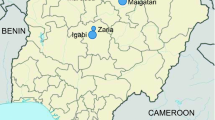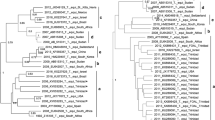Abstract
Piroplasmosis is a disease that negatively affects equine health worldwide. Hence, 324 blood samples were collected from grazing horses in ten sites in Xinjiang and testing them for the presence of Theileria equi and Babesia caballi by PCR of the EMA-1 gene and BC48 gene, respectively. Of the 324 blood samples, 161 (49.7%) were positive for equine piroplasms. The prevalence of T. equi was 38.9% (126/324), while that of B. caballi was 30.2% (98/324). The T. equi and B. caballi co-infection rate was 19.4% (63/324). From the 126 EMA-1 gene sequences and 98 BC48 gene sequences we obtained, 21 and 27 genotypes were identified, respectively. The EMA-1 sequences together with the GenBank reference sequences grouped into four clusters, with those from the present study forming two distinct clusters. In contrast, the BC48 sequences formed eight clusters with the GenBank reference sequences, while those obtained in the present study formed five distinct clusters. Our results highlight the widespread distribution and abundant gene polymorphism of T. equi and B. caballi in grazing horses from Xinjiang.



Similar content being viewed by others
Data availability
All of the data generated and analyzed during this study are included in this published manuscript. The nucleotide sequences obtained in this study have been deposited in GenBank under accession numbers: MK580502-MK580528 and MK568953-MK568972.
References
Battsetseg B, Lucero S, Xuan X, Claveria FG, Inoue N, Alhassan A, Kanno T, Igarashi I, Nagasawa H, Mikami T, Fujisaki K (2002) Detection of natural infection of Boophilus microplus with Babesia equi and Babesia caballi in Brazilian horses using nested polymerase chain reaction. Vet Parasitol 107(4):351–357. https://doi.org/10.1016/s0304-4017(02)00131-0
Buling A, Criado-Fornelio A, Asenzo G, Benitez D, Barba-Carretero JC, Florin-Christensen M (2007) A quantitative PCR assay for the detection and quantification of Babesia bovis and B bigemina. Vet Parasitol 147(1–2):16–25. https://doi.org/10.1016/j.vetpar.2007.03.031
Cacciò S, Cammà C, Onuma M, Severini C (2000) The beta-tubulin gene of Babesia and Theileria parasites is an informative marker for species discrimination. Int J Parasitol 30(11):1181–1185. https://doi.org/10.1016/s0020-7519(00)00105-3
Davitkov D, Vucicevic M, Stevanovic J, Krstic V, Slijepcevic D, Glavinic U, Stanimirovic Z (2016) Molecular detection and prevalence of Theileria equi and Babesia caballi in horses of central Balkan. Acta Parasitol 61(2):337–342. https://doi.org/10.1515/ap-2016-0044
Díaz-Sánchez AA, Pires MS, Estrada CY, Cañizares EV, Del Castillo Dominguez SL, Cabezas-Cruz A, Rivero EL, da Fonseca AH, Massard CL, Corona-González B (2018) First molecular evidence of Babesia caballi and Theileria equi infections in horses in Cuba. Parasitol Res 117(10):3109–3118. https://doi.org/10.1007/s00436-018-6005-5
Dominguez M, Munstermann S, Murray G, Timoney P (2015) ‘High-health, high-performance’ horses: risk mitigation strategies for OIE-listed diseases. Rev Sci Tech 34(3):837–848. https://doi.org/10.20506/rst.34.3.2399
Ebrahimi M, Adinehbeigi K, Hamidinejat H, Tabandeh MR (2018) Molecular characterization of Theileria equi infection in horse populations belonging to West Azerbaijan, Iran: insights into the importance of equine merozoite antigen (EMA)-1 in its diagnosis. Annal Parasitol 64(1):21–27. https://doi.org/10.17420/ap6401.128
Hussain MH, Saqib M, Raza F, Muhammad G, Asi MN, Mansoor MK, Saleem M, Jabbar A (2014) Seroprevalence of Babesia caballi and Theileria equi in five draught equine populated metropolises of Punjab. Pakistan Vet Parasitol 202(3–4):248–256. https://doi.org/10.1016/j.vetpar.2014.01.026
Liu S, Guo Q, Wen X, Zhang M, Dang N, Alax A, Chahan B (2017) Differences in Theileria equi infection and its phylogenetic development analysis in some areas of Xinjiang. Xinjiang Agric Sci 54:2130–2317. https://doi.org/10.6048/j.issn.1001-4330.2017.11.021
Mahmoud MS, El-Ezz NT, Abdel-Shafy S, Nassar SA, El Namaky AH, Khalil WK, Knowles D, Kappmeyer L, Silva MG, Suarez CE (2016) Assessment of Theileria equi and Babesia caballi infections in equine populations in Egypt by molecular, serological and hematological approaches. Parasit Vectors 9:260. https://doi.org/10.1186/s13071-016-1539-9
Manna G, Cersini A, Nardini R, Bartolome Del Pino LE, Antognetti V, Zini M, Conti R, Lorenzetti R, Veneziano V, Autorino GL, Scicluna MT (2018) Genetic diversity of Theileria equi and Babesia caballi infecting horses of Central-Southern Italy and preliminary results of its correlation with clinical and serological status. Ticks Tick Borne Dis 9(5):1212–1220. https://doi.org/10.1016/j.ttbdis.2018.05.005
Mehlhorn H, Schein E (1998) Redescription of Babesia equi Laveran, 1901 as Theileria equi Mehlhorn, Schein 1998. Parasitol Res 84(6):467–475. https://doi.org/10.1007/s004360050431
Montes Cortés MG, Fernández-García JL, Habela Martínez-Estéllez MÁ (2017) Seroprevalence of Theileria equi and Babesia caballi in horses in Spain. Parasite 24:14. https://doi.org/10.1051/parasite/2017015
Munkhjargal T, Sivakumar T, Battsetseg B, Nyamjargal T, Aboulaila M, Purevtseren B, Bayarsaikhan D, Byambaa B, Terkawi MA, Yokoyama N, Igarashi I (2013) Prevalence and genetic diversity of equine piroplasms in Tov province, Mongolia. Infect Genet Evol 16:178–185. https://doi.org/10.1016/j.meegid.2013.02.005
Ozubek S, Aktas M (2018) Genetic diversity and prevalence of piroplasm species in equids from Turkey. Comp Immunol Microbiol Infect Dis 59:47–51. https://doi.org/10.1016/j.cimid.2018.08.005
Posada-Guzmán MF, Dolz G, Romero-Zúñiga JJ, Jiménez-Rocha AE (2015) Detection of Babesia caballi and Theileria equi in blood from equines from four indigenous communities in Costa Rica. Vet Med Int 2015:236278. https://doi.org/10.1155/2015/236278
Qablan MA, Oborník M, Petrželková KJ, Sloboda M, Shudiefat MF, Hořín P, Lukeš J, Modrý D (2013) Infections by Babesia caballi and Theileria equi in Jordanian equids: epidemiology and genetic diversity. Parasitology 140(9):1096–1103. https://doi.org/10.1017/S0031182013000486
Sumbria D, Das Singla L, Sharma A (2016) Theileria equi and Babesia caballi infection of equids in Punjab, India: a serological and molecular survey. Trop Anim Health Prod 48(1):45–52. https://doi.org/10.1007/s11250-015-0917-1
Veronesi F, Morganti G, Ravagnan S, Laus F, Spaterna A, Diaferia M, Moretti A, Fioretti DP, Capelli G (2014) Molecular and serological detection of tick-borne pathogens in donkeys (Equus asinus) in Italy. Vet Microbiol 173(3–4):348–354. https://doi.org/10.1016/j.vetmic.2014.08.017
Vieira MIB, Costa MM, de Oliveira MT, Goncalves LR, Andre MR, Machado RZ (2018) Serological detection and molecular characterization of piroplasmids in equids in Brazil. Acta Trop 179:81–87. https://doi.org/10.1016/j.actatropica.2017.12.028
Wise LN, Kappmeyer LS, Mealey RH, Knowles DP (2013) Review of equine piroplasmosis. J Vet Intern Med 27(6):1334–1346. https://doi.org/10.1111/jvim.12168
Ybañez AP, Ybañez RHD, Talle MG, Arreglo RMT, Geens MJC, Villas JGI 3rd, Villar SR, Laruga CL, Cao S, Moumouni FPA, Liu M, Igarashi I, Xuan X (2018) Serological and molecular detection of Theileria equi and Babesia caballi in Philippine horses. Ticks Tick Borne Dis 9(5):1125–1128. https://doi.org/10.1016/j.ttbdis.2018.04.010
Zanet S, Bassano M, Trisciuoglio A, Taricco I, Ferroglio E (2017) Horses infected by Piroplasms different from Babesia caballi and Theileria equi: species identification and risk factors analysis in Italy. Vet Parasitol 236:38–41. https://doi.org/10.1016/j.vetpar.2017.01.003
Zhang Y, Chahan B, Liu S, Song R, Li Y, Huercha GQ, Wu H, Zhu Y (2017) Epidemiologic studies on Theileria equi infections for grazing horses in Ili of Xinjiang province. Vet Parasitol 244:111–113. https://doi.org/10.1016/j.vetpar.2017.07.014
Funding
This work was supported by the Program for Young and Middle-aged Leading Science, Technology, and Innovation of Xinjiang Production & Construction Corps (2018CB034).
Author information
Authors and Affiliations
Contributions
MQ and CSN contributed to the conception and design of the experiments. JW, FCY, and DYT performed sample collection. DYT and AYZ were involved in data collection and analysis. YYC and GM helped drafting and reviewing the manuscript. All of the authors read and approved the final manuscript.
Corresponding author
Ethics declarations
Ethical approval
The research protocol was reviewed and approved by the Research Ethics Committee of Tarim University (Approval No. IRC-TARU-20180403–02). Appropriate permission was obtained from the farm owners before collecting blood samples from their horses.
Conflict of interest
The authors declare no competing interests.
Additional information
Section Editor: Abdul Jabbar
Publisher's note
Springer Nature remains neutral with regard to jurisdictional claims in published maps and institutional affiliations.
Rights and permissions
Springer Nature or its licensor (e.g. a society or other partner) holds exclusive rights to this article under a publishing agreement with the author(s) or other rightsholder(s); author self-archiving of the accepted manuscript version of this article is solely governed by the terms of such publishing agreement and applicable law.
About this article
Cite this article
Wu, J., Cui, Y., Yu, F. et al. Prevalence and genetic characterization of Theileria equi and Babesia caballi in grazing horses in Xinjiang, northwestern China. Parasitol Res 122, 387–394 (2023). https://doi.org/10.1007/s00436-022-07749-4
Received:
Accepted:
Published:
Issue Date:
DOI: https://doi.org/10.1007/s00436-022-07749-4




